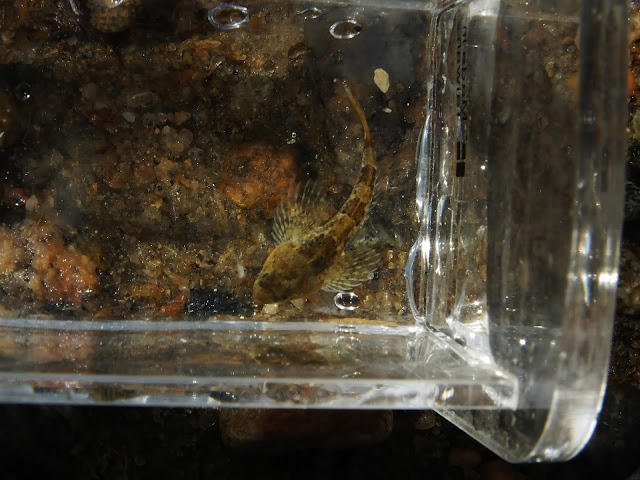 |
| A coyote raided turtle nest. |
Then, wading through some sandy areas, I noticed I was spooking a bunch of little flatfish. Some were definitely juvenile summer flounder, the rest were hogchoker. I started targeting them, which was very, very frustrating. These little flat fish may turn out to be extremely hard for me to add to my lifelist. I eventually had to call it quits and head back towards the car. But I did decide to walk along the edge of the breachway instead of the road on the way there. I found some more hogchokers hanging around a few rocks, but in trying to catch them, I ended up catching something very different. I saw come out from under a weed covered rock a pair of very stout fish with big heads and mottled coloration. They were clearly sculpins of some sort. And, true to the ravenous nature of many sculpins, they pounced on my tiny tanago hook fly. I hooked it and immediately lifted it's incredibly minuscule body out of the water. My heartbeat increased rapidly as I carefully waded back to dry land, worrying all the way that the fish would free itself, knowing full well this could only be a new species no matter what sculpin it turned out to be. I quickly got it into the photo-tank, before which time it did indeed throw the hook, and got as many photos as I could. Then I went back out and tried to get the other one, which was bigger. I did, and I got it safely into the photo tank too, where I was lucky enough to get one key photo, though I didn't know that until I got home. These are the results from both fish:
 |
| Specimen #1 |
 |
| Specimen #2 |
Now, for the aforementioned key photo of the larger of the two sculpins:
Why, you are probably asking, is this the key photo? It is a bit less well focused than the rest and doesn't seem to show some key parts of the fish in any detail.
Well, it shows one specific part of the fish in enough clarity for me to confidently identify the species. These two fish could only really have been either shorthorned sculpins or little sculpins, also called grubbies. It was much more likely that they were grubbies because they are more common than shorthorned south of Cape Cod Bay, and shorthorned sculpins are rarely in very shallow water in the summer up north. So it would stand to reason that in Southern New England in a spot with water temperatures just above 60 degrees, these would most likely be grubbies. But weirder things have happened in this spot than a shorthorned sculpin showing up in late June... just 25 yards away, I'd caught a barrelfish on the fly... so it could go either way. Except I got a good enough shot of the larger specimens anal fin with rays extended to get a count of 10.
Grubbies have 10 or 11 anal fin rays, shorthorned sculpins have 13 or 14.
So, life list fish #133 for me is the little sculpin. It had been far too long since I got a new fish to add to the list. What a relief! Only 17 to go before I reach my year end goal of 150.
 |
| Lifelist fish # 133, little sculpin/grubby, Myoxocephalus aenaeus. Rank: species |
If you enjoy what I'm doing here, please share and comment. It is increasingly difficult to maintain this blog under dwindling readership. What best keeps me going so is knowing that I am engaging people and getting them interested in different aspects of fly fishing, the natural world, and art. Follow, like on Facebook, share wherever, comment wherever. Also, consider supporting me on Patreon (link at the top of the bar to the right of your screen, on web version). Every little bit is appreciated! Thank you to my Patrons; Erin, David, john, and Christopher, for supporting this blog.









Cool!
ReplyDeleteThank you.
DeleteSuper cool day afield RM. I saw one green snake years and years ago while fishing quabbin from shore here in MA. It was, indeed, to fast to catch! Keep searching, if you can find rattlers, you can find a green snake :)! (any rattler adventures this year?)
ReplyDeleteAwesome on the little sculpin as well - that's a very cool catch!
Will
I've been. Have seen a few large gravid females.
DeleteNice !
ReplyDeleteThank you.
DeleteI enjoyed this blog post so much! I wonder and this is not a judgement question in any way, do you keep the specimen you catch in a cool varied species tank or send them back to the water?
ReplyDeleteI release anything that isn't of scientific importance or that I don't plan to eat. If I catch a non-native species that hasn't been documented in that area, the protocol is preservation in alcohol and careful records. If I ever am so lucky as to catch a species that is likely unclassified, that will also be the protocol.
Delete